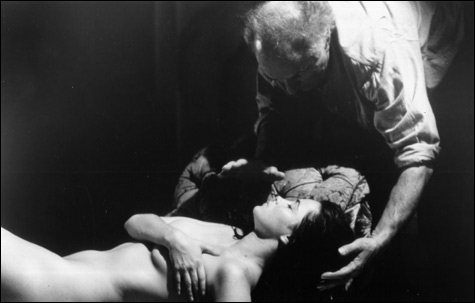
LA BELLE NOISEUSE: Remember Emmanuelle Béart buck-naked as an artist’s model for hours of screen time? |
It’s a masterpiece, if predominantly for what it creates in the air between screen and viewer, outside the ordinary channels of communication. The mysteries of Paris — the almost Pynchonian sense of a secret city within the visible one — is integral to Rivette’s career project, however consciously or not he expanded on the notion embodied by the France-beloved pre-WWI serials of Louis Feuillade. (Typically, 1916’s Les vampires is a vision of the City of Light as a depopulated, trapdoor haunted house, and today it seems less Feuilladian in that aspect than Rivettian-before-the-fact.)
Following his singular ideas of what cinema should be (Rivette began as one of the more lacerating Cahiers du cinéma critics, famous for declaring that for a single camera movement in Kapo director Gillo Pontecorvo “is worthy of the most profound contempt”), the filmmaker has also become famous for redefining movie length — his most notorious film, the rarely seen Out One (1970), is more than 12 hours long, another semi-improvised tapestry of unarticulatable uneasiness, with a vast cast of obsessive characters (the stars include Jean-Pierre Léaud, Juliet Berto, and Bulle Ogier) rehearsing two different Aeschylus plays simultaneously and surviving monstrous narrative chaos in the process. (After shooting his contribution to the 1995 omnibus film Lumière &Co. — which was predicated on contemporary directors using the original Lumière camera to craft their own 51-second Lumière movie — Rivette smiled to the camera and said, “Too short.”) Out One’s length itself becomes the defining theme of the film — however demanding, after a quarter or a third, the film begins to occupy and control your consciousness like a powerful hallucinogen. (For Rivette, short movies are a form of evasion that allow the viewer to get in and get out too easily, without commitment or sacrifice.) Such is also the case with his even more menacing rearrangement/reduction titled OUT ONE: SPECTRE (1972; January 8 at 7 pm), and L’AMOUR FOU (1969; January 18 + 20 at 7 pm), La belle noiseuse, and JEANNE LA PUCELLE|JOAN THE MAID (1994; February 3 + 5 at 7 pm), all of them four or more hours long and each fraught with the tension between its surface materials — performance, art, martyrdom — and the intimations of a secret government beneath our perceptions.
Did I hear “quantum cinema”? Rivette’s subject is certainly movies and their elusive wave-and-particle-ness, but he returns to theater — specifically, rehearsals — in more movies than not. It may seem odd, particularly given that over the years he’s been only nominally interested in directing theater. But in the viewing, the trope makes perfect sense — theater’s the artificial yet humanist bridge between what’s real and what’s cinematic (an amalgam, after all, of light and plastic), as honest about its contrivances as movies are secretive and duplicitous. Of course, the categories are subject to slippage — in Out One: Spectre, L’amour fou,L’AMOUR PAR TERRE|LOVE ON THE GROUND (1984; January 16 at 7 pm), and LA BANDE DES QUATRE|GANG OF FOUR (1988; January 15 at 7 pm), we’re often unsure whether the actors are performing a dramatic text or just talking (either way, they’re still in a movie!), just as in the merely three-hour CELINE ET JULIE VONT EN BATEAU|CELINE AND JULIE GO BOATING (1974; January 7 at 2 + 7 pm), arguably Rivette’s greatest film, inhabiting a theatrical narrative becomes a movie-within-a-movie, neither of which has a diegetic “reality” to speak of — or, as critic David Thomson put it, “whereas [Citizen] Kane was the first picture to suggest that the world of the imagination was as powerful as reality, Céline and Julie is the first film in which everything is invented.”